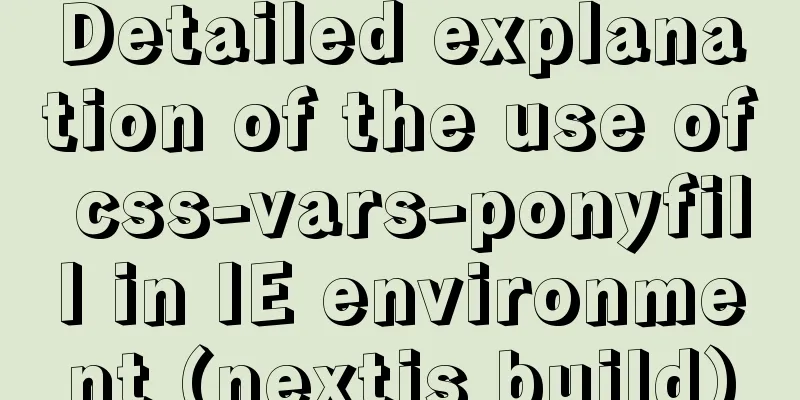Detailed explanation of the use of css-vars-ponyfill in IE environment (nextjs build)

|
css-vars-ponyfill When using CSS variables to achieve web page skinning, compatibility issues may arise.
In order to solve the compatibility issues of IE, QQ, Baidu browser, etc., css-vars-ponyfill was introduced. However, in IE browser, css-vars-ponyfill performs poorly under nextjs. The main defect is that since the page is rendered on the server side, after the user sees the interface, dynamic theme colors and other styles cannot be rendered quickly, but there is a transition time (css-vars-ponyfill only supports client-side), and there will be an obvious color replacement process, which leads to poor user experience. By reading the source code, we can see that cssVars needs to wait until the browser content is loaded before it is triggered. Otherwise, it will keep listening to the dom's data content event, which will cause experience problems. Solution 1. Parsing speed By directly removing the restriction condition of 2. Analysis stability By manually changing the file parsing location and making relevant changes to the conditional trigger mechanism of the source code, the color rendering speed of the home page has been improved to a certain extent. However, there is still a problem. That is, when a new style chunk is inserted through the route jump interface, effective CSS variable parsing cannot be performed (I have tried to configure the cssVars option to turn on MutationObserver). Therefore, the solution is to determine the UA so that all routes in browsers such as IE can be redirected through the a tag, triggering the re-parsing and execution of css-ponyfill.
export function browser() {
const UA = window.navigator.userAgent
if (UA.includes("qqbrowser")) return "qqbrowser"
if (UA.includes("baidu")) return "baidu"
if (UA.includes("Opera")) return "Opera"
if (UA.includes("Edge")) return "Edge"
if (UA.includes("MSIE") || (UA.includes("Trident") && UA.includes("rv:11.0")))
return "IE"
if (UA.includes("Firefox")) return "Firefox"
if (UA.includes("Chrome")) return "Chrome"
if (UA.includes("Safari")) return "Safari"
}
type CommonLinkProps = {
children: ReactElement
href?: string
target?: string
outerLink?: boolean
styles?: unknown
}
export default function CustomLink(props: CommonLinkProps) {
const { children, href, target, as, outerLink, styles = emptyStyles } = props
const [isIE, setIE] = useState<boolean>(false)
const cloneEl = (c: ReactElement, props?: any) =>
React.cloneElement(c, { href: as ?? href, target, ...props })
useEffect(() => {
if (["IE", "qqbrowser", "baidu"].includes(browser())) {
setIE(true)
}
}, [])
function renderLink() {
if (Children.only(children).type === "a") {
const node = cloneEl(children as ReactElement)
return node
} else {
let fn: () => void | null = null
if (outerLink) {
fn = () => {
window.open(as ?? href)
}
} else {
fn = () => {
window.location.href = as ??href
}
}
const node = cloneEl(children as ReactElement, {
onClick: () => {
fn()
},
})
return node
}
}
return (
<>
{!href ? (
children
) : isIE ? (
renderLink()
) : (
<Link {...props}>{children}</Link>
)}
<style jsx>{styles}</style>
</>
)
} Here, the type of children is Summarize This is the end of this article about the use of css-vars-ponyfill in the IE environment (nextjs build). For more relevant css-vars-ponyfill usage content, please search 123WORDPRESS.COM's previous articles or continue to browse the following related articles. I hope everyone will support 123WORDPRESS.COM in the future! |
<<: Json string + Cookie + localstorage in JS
>>: Detailed process of FastAPI deployment on Docker
Recommend
Detailed explanation of three solutions to the website footer sinking effect
Background Many website designs generally consist...
Analyze how to automatically generate Vue component documentation
Table of contents 1. Current situation 2. Communi...
The most commonly used HTML escape sequence
In HTML, <, >, &, etc. have special mean...
A brief introduction to the usage of decimal type in MySQL
The floating-point types supported in MySQL are F...
Solve the abnormal error when building vue environment with webpack
Table of contents First, configure package.json T...
Detailed explanation of the payment function code of the Vue project
1. Alipay method: Alipay method: Click Alipay to ...
Vue recursively implements three-level menu
This article example shares the specific code of ...
The concept of MySQL tablespace fragmentation and solutions to related problems
Table of contents background What is tablespace f...
JavaScript in-depth analysis of the direction of this and how to modify the direction
Table of contents this Method In the object Hidde...
Examples of using HTML list tags dl, ul, ol
Copy code The code is as follows: <!-- List ta...
A brief analysis of using JDBC to operate MySQL requires adding Class.forName("com.mysql.jdbc.Driver")
introduction If you are familiar with using JDBC ...
Implementation of Docker data volume operations
Getting Started with Data Volumes In the previous...
How to install mysql5.7 in windows
First download the compressed version of mysql, t...
Solution to prevent caching in pages
Solution: Add the following code in <head>: ...
How to create a responsive column chart using CSS Grid layout
I have been playing around with charts for a whil...










